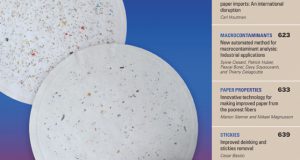VIPIN SUMANI AND THOMAS S. SEGULJIC
The pulp and paper industry is one of the heaviest users of water in the US, using almost 15,000 gallons of water per ton of finished product. With water used in nearly every step of the production process, the large volumes of wastewater and residual sludge waste present treatment, discharge and disposal issues.
Coupled with the development of innovative water reuse and treatment technologies, mills have numerous options to reduce, reuse and treat wastewater. This article describes the typical best practices and strategies used in the pulp and paper industry to manage water, including ways to reduce the water usage in a typical mill.
PULP AND PAPER WATER BALANCE
Many of the processes in a mill use water; however, not every process needs raw or treated water and water can be cascaded or reused in many places. The main sources of water for manufacturing operations include: surface water; ground water; purchased water; and rain.
 The majority of water is lost to the atmosphere as evaporative losses. A smaller amount of water (< 1 percent) also leaves as water in the solids residuals (as moisture in the solids.) The remainder is treated through the wastewater treatment system and discharged to the receiving water body.
The majority of water is lost to the atmosphere as evaporative losses. A smaller amount of water (< 1 percent) also leaves as water in the solids residuals (as moisture in the solids.) The remainder is treated through the wastewater treatment system and discharged to the receiving water body.
Figure 1 shows an example of the water balance in a typical mill. Little can be done to capture the evaporative losses, but best practices on wastewater consumption and reuse opportunities within manufacturing operations can provide significant water savings. Best practices management pertaining to wastewater treatment and reuse are provided in the following sections.
WASTEWATER OVERVIEW
Looking first at pulping, this involves debarking, wood chipping, chip washing, chip digestion, pulp screening, thickening and washing. Further mechanical and chemical processes are used to enhance the overall quality and the pulping yield. Kraft pulping is usually carried out in the presence of alkaline media such as sodium hydroxide and sodium sulfide. The sulfide process, an acidic pulping process, is carried out in the presence of sulphurous acid and bisulfide ions. The production of white paper involves additional bleaching processes in conjunction with pulping processes.
The wastewater generated from commonly used pulping and bleaching processes is high in color, BOD/COD, chlorinated organic, and solids.
TYPICAL IMPURITIES
IN WASTEWATER
The wastewaters generated from the pulp and paper process typically contain the following contaminants:
• Biological Oxygen Demand (BOD): The amount of dissolved oxygen needed by aerobic biological organisms to break down the organic material in the influent wastewater. BOD in the wastewater can largely be attributed to the ![]() initial steps of wood preparation, chip digester, post pulping, and bleaching operations. The wastewater effluent is heavily loaded with high BOD content.
initial steps of wood preparation, chip digester, post pulping, and bleaching operations. The wastewater effluent is heavily loaded with high BOD content.
• Chemical Oxygen Demand (COD): The measurement of all the chemicals in the wastewater that need to be oxidized. High COD content is commonly attributed to the chemical pulping process and bleaching operations.
• Chlorinated Organics: Primarily adsorbable organic halides (AOX) contained in the wastewater generated from pulp bleaching.
• Total Suspended Solids (TSS): Settleable and non-settleable solids in the influent wastewater stream. These are primarily bark particles, lost cellulose fiber, fiber debris, and dissolved organic compounds such as dissolved lignin compounds, carbohydrates, starch, and hemi-cellulose. High solids content is generated during the initial wood preparation process for pulping.
WASTEWATER TREATMENT
Wastewater treatment can include primary, secondary, and tertiary treatment steps.
Primary treatment is a physical operation, usually gravity separation, to remove the floating and the settleable solids in the wastewater. Primary treatment can comprise of grit removal and screening, sedimentation, and floatation followed by filtration. The effluent from the primary sedimentation is sent for further solids removal to a dissolved air flotation (DAF) unit; the type of DAF needs to be evaluated based on the influent conditions, type of operations, and the required outlet conditions.
Efficiently designed sedimentation tanks, in conjunction with DAF and filtration, can remove 80 to 85 percent of the suspended solids and from 30 to 40 percent of the overall BOD load. Figure 2 shows the typical block flow diagram for primary treatment.
In secondary treatment, biological treatment is used for removal of the organic compounds following the removal of suspended solids in the primary treatment. The principal biological treatments are: suspended growth processes; and attached growth processes.
The suspended growth biological process involves the microorganisms to be maintained as suspension in the liquid by appropriate mixing methods. These microorganisms use the organic constituents within the wastewater as their food source and form an active biomass within the liquid to oxidize the organic content of the incoming feed wastewater. The most common suspended growth process used in the industry is the activated sludge process and is discussed later. Figure 3 shows a typical block diagram for activated sludge process (ASP).
ASP is comprised of the following elements: aeration tank; air intake system; and clarifier.
The wastewater from primary treatment process enters the aeration tank, where sufficient contact time is provided for mixing and aeration of the influent wastewater with the microbial suspension. Air is continuously injected with the help of mechanical equipment in the aeration tank to keep the environment aerobic and the solids in suspension. The microbial suspension in the aeration tank is referred to as mixed liquor suspended solids (MLSS). The organic portion of the suspension is referred to as mixed liquor volatile suspended solids (MLVSS).
 The effluent from the aeration tank is sent to the clarifier. The portion of thickened and settled biomass is recirculated back to the aeration tank for the continuous biodegradation of the organics in the influent wastewater. A portion of settled biomass/thickened solids is removed as waste activated sludge. The clarified effluent, now low in suspended solids, BOD and COD, is further sent for tertiary treatment within the wastewater treatment plant. A properly designed activated sludge system can significantly reduce the BOD and COD by over 90 percent.
The effluent from the aeration tank is sent to the clarifier. The portion of thickened and settled biomass is recirculated back to the aeration tank for the continuous biodegradation of the organics in the influent wastewater. A portion of settled biomass/thickened solids is removed as waste activated sludge. The clarified effluent, now low in suspended solids, BOD and COD, is further sent for tertiary treatment within the wastewater treatment plant. A properly designed activated sludge system can significantly reduce the BOD and COD by over 90 percent.
ASP has been successfully used in conjunction with the use of powdered activated carbon (PACT) to enhance the overall biological oxidation with the aid of carbon adsorption.
In attached growth processes, microorganisms are attached to an inert material rather than being suspended in the liquid. A typical example would be the use of a trickling filter. Due to size and other constraints, attached growth processes are not typically used in the industry.
Tertiary treatment further involves the reduction of contaminants to meet the regulatory limits. This can involve the following treatment technologies:
• Sand filtration – Effluent from the biological activated sludge process is high in effluent solids. Sand filters can effectively filter the solids from the effluent of the activated sludge process. This process involves the passing of wastewater through a filter bed comprised of filter media such as sand and anthracite. Larger size solids particles are captured in the anthracite media; finer particles are captured in the sand media.
• Chemical oxidation – This is generally used for the reduction of the residual COD and non-biodegradable compounds. Advanced oxidation methods such as Fentons reagents, wet oxidation, and ozone oxidation methods have been used to oxidize and destruct the chromophoric and nonchromophoric pollutants.
• Activated carbon treatment – Residual organic compounds and color from the biological treatment system can be removed by carbon adsorption. This technology is used is as a final polishing step to aid the removal of any residual organics and color that have been left unprocessed in the biological system. This technology involves passing the wastewater over a granular bed of activated carbon. The organic pollutants, depending on the isotherm, are adsorbed on the surface of the carbon, thereby removing the organic pollutants from the wastewater stream prior to discharge.
• Membrane filtration – Membrane filtration technologies such as reverse osmosis have been used to remove the BOD/COD, heavy metals and total dissolved solids from the effluent stream prior to discharge.
RECYCLE/REUSE:
ADVANTAGES, CONCERNS
Recycle and reuse technologies are available for treated wastewater. Currently, very few mills have used these technologies for the reuse of wastewater. The options that should be considered in conjunction with the primary and secondary treatment for water reuse purposes follow:
• Microfiltration – Microfiltration removes the suspended solids better than the traditional clarifiers.
• Reverse osmosis – Reverse osmosis (RO) is a membrane technology that can potentially remove dissolved salts, COD/BOD, and metals found in the pulp and paper effluent. RO technology is suitable to produce a product water quality suitable for reuse at the pulp and paper mill. These technologies are installed downstream of biologically pretreated wastewaters.
Advantages and drivers: Closed mill operation provides significant advantages to the mill. These are some of the advantages that should be considered in the selection of water conservation:
• Energy savings: The water produced in the mill operation is warm and, if recycled, it can provide significant energy savings.
• Environmental liability: The wastewater effluent from the mill must conform to the discharge standards as regulated by local and federal agencies. These regulatory limits are becoming more stringent over time. Closed mill operation and recycling the treated water for consumption within the mill reduces the environmental liability risk associated with wastewater discharge.
• Water savings: Water recycling will reduce the overall water consumption in the mill, thereby providing savings in the costs associated with fresh water and wastewater treatment.
Overall, recycle/reuse of the water within a mill reduces the volume of wastewater generated and provides significant energy savings, which eventually helps reduce mill production costs.
Potential concerns: The recycle/reuse of water within a mill is not without its concerns. For instance, corrosion can be a problem. There have been issues associated with the buildup of non-process elements such as silica within the system; silica can cause scaling, thereby causing corrosion of the downstream equipment within the plant, which can affect overall product quality.
The selection of recycle/reuse technology should be site specific and should be evaluated on a case-by-case basis. Mills should use the following set of suggested criteria when evaluating a specific technology:
• Product water quality specification;
• Extent of prior use of technology;
• Operation and flexibility;
• Plot space requirements;
• Capital and operating costs.
BEST PRACTICE MANAGEMENT OF PROCESS STREAMS
The following best practices should be followed for water use reduction within the industry:
• A dry debarking process should be implemented in lieu of a wet debarking process. Dry debarking can significantly reduce water consumption. The wastewater quality associated with the dry debarking process has less solids and BOD loading, thereby making the downstream equipment more efficient.
• Provide spill containment and collection systems for the black liquor in kraft pulp mills.
• A chlorine-free bleaching system should be considered.
• Soft water should be used for the boiler feed water.
CONCLUSION
Pulp and paper manufacturing requires a substantial amount of water. Due to the high consumption of raw water within mills, along with the fresh water shortage afflicting many parts of the world, the pressure to recycle and reuse water is constantly increasing. As such, the industry should evaluate the potential uses of recycled water within mills.
Source segregation of process streams, along with end-of-pipe treatment technologies, should be evaluated in detail to optimize overall water consumption. Advanced technologies should be used in lieu of conventional treatment technologies to minimize water loss and provide high quality water that can be recycled and reused within a mill.
References
• Metcalf and Eddy, Wastewater Engineering – Treatment and Reuse, 4th Edition, McGraw Hill.
• Rase, Howard F., and Barrow, M.H., Project Engineering for Process Plants, John Wiley and Sons Inc.
• Bahar K. Ince1, Zeynep Cetecioglu2 and Orhan Ince2, Pollution Prevention in the Pulp and Paper Industries. 1Bogazici University, Institute of Environmental Science, Istanbul; 2Istanbul Technical University, Environmental Engineering Department, Istanbul, Turkey.
• Afonso, M.D. and M. N. Pinho, Membrane separation processes in pulp and paper production. Filtr. Sep., Vol.2, No.1, pp.42– 4.
• Jankunaite, Dalia: Pulp and paper industry – Case Study (www.forestproducts.sca.com).
Thomas Seguljic, PE, is vice president and Vipin K. Sumani, PE, is project manager at HRP Associates Inc., a multidisciplinary environmental and engineering consulting firm with nine offices throughout the US.
Fig. 1: Water balance in a typical paper mill.
Fig. 2: Typical block flow diagram of primary wastewater treatment.
Fig. 3: Typical block diagram of the activated sludge process.
 Paper 360
Paper 360


